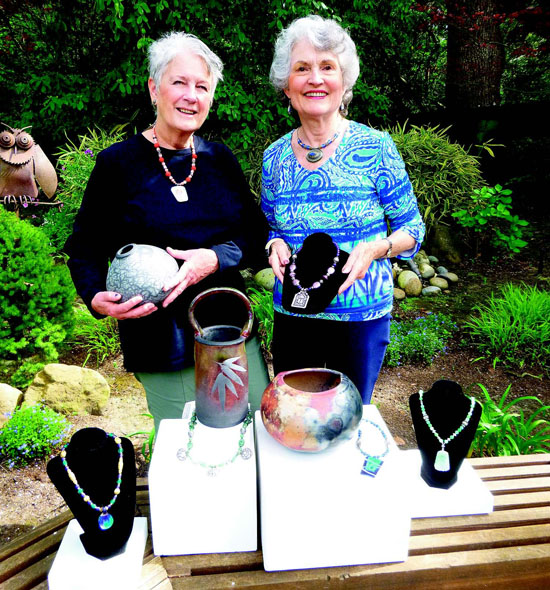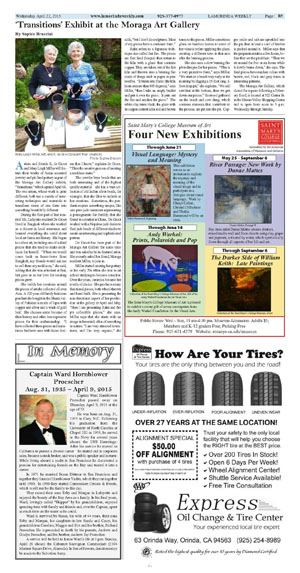|
|
Published April 22nd, 2015
|
'Transitions' Exhibit at the Moraga Art Gallery
|
|
| By Sophie Braccini |
 |
| Mary Leigh Miller, left, and K. de Groot present their creations. Photo Sophie Braccini |
Artists and friends K. de Groot and Mary Leigh Miller will feature their works of Asian-accented jewelry and pit-fired pottery as part of the Moraga Art Gallery exhibit, "Transitions," which opened April 18. The two artists, whose work is quite different, both use a variety of interesting techniques and materials to transform items of one form into something beautifully different.
 During the first part of her married life, Lafayette resident De Groot lived in Bangkok where she worked as a docent in local museums and learned everything she could about local art forms and history. She began to collect art, including one-of-a-kind pieces that she used to make necklaces for herself. "When we would come back on home-leave from Bangkok, my friends would ask me to sell them my necklaces," she said, adding that she was reluctant at first, but gave in as her love for creating pieces grew.
During the first part of her married life, Lafayette resident De Groot lived in Bangkok where she worked as a docent in local museums and learned everything she could about local art forms and history. She began to collect art, including one-of-a-kind pieces that she used to make necklaces for herself. "When we would come back on home-leave from Bangkok, my friends would ask me to sell them my necklaces," she said, adding that she was reluctant at first, but gave in as her love for creating pieces grew.
 She builds her creations around the pieces of art she collected all over Asia. A 100-year-old family heirloom pendant she bought in the Hunza valley of Pakistan is made of lapis with copper and silver and a wash of gold leaf. She chooses some because of their history and other less expensive pieces for their craftsmanship. "I have collected these pieces and sometimes find new ones with Asian dealers that I know," explains de Groot. "Then the creative process of creating a necklace starts."
She builds her creations around the pieces of art she collected all over Asia. A 100-year-old family heirloom pendant she bought in the Hunza valley of Pakistan is made of lapis with copper and silver and a wash of gold leaf. She chooses some because of their history and other less expensive pieces for their craftsmanship. "I have collected these pieces and sometimes find new ones with Asian dealers that I know," explains de Groot. "Then the creative process of creating a necklace starts."
 The jeweler buys beads that are both interesting and of the highest quality material - she has a vast collection of old Indian silver beads, for example, that she likes to include in her creations. Sometimes, the pendants require something unique, like one pure jade ornament representing a pomegranate for fertility that she found in a market in China. De Groot worked with a Nepalese jade dealer to find jade beads of different shades to create an interesting and sophisticated pattern.
The jeweler buys beads that are both interesting and of the highest quality material - she has a vast collection of old Indian silver beads, for example, that she likes to include in her creations. Sometimes, the pendants require something unique, like one pure jade ornament representing a pomegranate for fertility that she found in a market in China. De Groot worked with a Nepalese jade dealer to find jade beads of different shades to create an interesting and sophisticated pattern.
 De Groot has been part of the Moraga Art Gallery for some time and was asked to be its featured artist. She recently asked her friend, Moraga resident Miller, to join in.
De Groot has been part of the Moraga Art Gallery for some time and was asked to be its featured artist. She recently asked her friend, Moraga resident Miller, to join in.
 Miller started creating her pottery in her early 20s when she was in art school studying to become a teacher. Over the years, ceramics became her media of choice. She produces many functional pieces, both wheel-thrown and hand-built. She is presenting the non-functional aspect of her production at the gallery in April and May. "Here I am presenting Raku and fire pit collectible pieces," she says. Miller says that she starts with an image in her mind, often of something in nature. "I am very attracted to textures, and I'm very organic," she adds, "but I don't do sculptures. Most of my pieces have a container form."
Miller started creating her pottery in her early 20s when she was in art school studying to become a teacher. Over the years, ceramics became her media of choice. She produces many functional pieces, both wheel-thrown and hand-built. She is presenting the non-functional aspect of her production at the gallery in April and May. "Here I am presenting Raku and fire pit collectible pieces," she says. Miller says that she starts with an image in her mind, often of something in nature. "I am very attracted to textures, and I'm very organic," she adds, "but I don't do sculptures. Most of my pieces have a container form."
 Raku refers to a Japanese technique also called fast fire. The pieces are first fired (bisque) then return to the kiln with a glaze that contains copper. They are taken out of the hot kiln and thrown into a burning fire made of things such as paper or pine needles. "It bursts into flame (the kiln heats at more than 800 degrees)," says Miller, "then I take an empty bucket and put it over the piece. It puts out the fire and smokes the piece." The white clay turns black; the glaze with its copper content adds red and brown tones to the pieces. Miller sometimes glues on bamboo leaves to some of her vessels before applying the glaze, creating a different tone in that area after the burning process.
Raku refers to a Japanese technique also called fast fire. The pieces are first fired (bisque) then return to the kiln with a glaze that contains copper. They are taken out of the hot kiln and thrown into a burning fire made of things such as paper or pine needles. "It bursts into flame (the kiln heats at more than 800 degrees)," says Miller, "then I take an empty bucket and put it over the piece. It puts out the fire and smokes the piece." The white clay turns black; the glaze with its copper content adds red and brown tones to the pieces. Miller sometimes glues on bamboo leaves to some of her vessels before applying the glaze, creating a different tone in that area after the burning process.
 She also uses a slow burning fire pit technique for her pieces. "This is a very primitive form," says Miller. "We start on a beach very early in the morning by digging a 15-foot long, 3-foot deep pit," she explains. "We add sawdust at the bottom, then we put down our pieces." Seaweed gathered on the beach and cow dung, which contains minerals that contribute to the process, are put into the pit. Copper oxide and salt are sprinkled into the pit, then at least a cord of lumber is packed around it. Miller says that the preparation takes a few hours, before they set the pit ablaze. "Then we sit around for five or six hours while it slowly burns down," she says. The final pieces have random colors with brown, red, black and gray tones in interesting patterns.
She also uses a slow burning fire pit technique for her pieces. "This is a very primitive form," says Miller. "We start on a beach very early in the morning by digging a 15-foot long, 3-foot deep pit," she explains. "We add sawdust at the bottom, then we put down our pieces." Seaweed gathered on the beach and cow dung, which contains minerals that contribute to the process, are put into the pit. Copper oxide and salt are sprinkled into the pit, then at least a cord of lumber is packed around it. Miller says that the preparation takes a few hours, before they set the pit ablaze. "Then we sit around for five or six hours while it slowly burns down," she says. The final pieces have random colors with brown, red, black and gray tones in interesting patterns.
 The Moraga Art Gallery, which closed for repairs following a February flood, is located at 522 Center St. in the Rheem Valley Shopping Center and is open from noon to 5 p.m. Wednesday through Sunday.
The Moraga Art Gallery, which closed for repairs following a February flood, is located at 522 Center St. in the Rheem Valley Shopping Center and is open from noon to 5 p.m. Wednesday through Sunday.

|
|
|
|
|
|
|
|
|
| |
|
|
|
|



